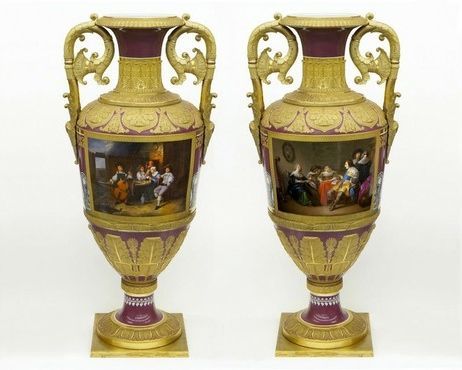Oil heirs discover old vases are million dollar czarist relics to be sold by the Dallas Auction Gallery
Two 4.5 foot Russian vases from the Imperial Porcelain Factory in 19th- century St. Petersburg formerly belonging to Frank and Merle Buttram are shown. They will be auctioned in Texas on April 17. Source: Randy Buttram via Bloomberg.
DALLAS, TX (BLOOMBERG).- Two gigantic vases that stood in the foyer of a mansion outside Oklahoma City are heading to auction on April 17 after a surprising evaluation.
Visiting his grandparents as a child, Randy Buttram didn’t give the vases much thought.
“They were there all the time,” said Buttram, 66, in a recent telephone interview. “I had no clue about their historical value.”
Estimated at $1 million to $1.5 million, the 4.5-foot-tall vases will be sold by the Dallas Auction Gallery, whose experts traced them back to the Imperial Porcelain Factory in 19th- century St. Petersburg.
Like so many czarist relics and museum masterpieces, they were probably sold to western buyers by the nascent and needy Soviet government.
In the mid-1920s, the vases appeared at the Bernheimer Gallery in Munich. Buttram’s grandparents, who were touring in Europe, bought them and recorded the purchase in their travel diary.
Buttram’s grandfather, Frank Buttram, was a rags-to-riches oil magnate and founder of Buttram Energies Inc. Born in a log cabin on Oklahoma’s Indian Territory, he made his fortune before turning 30 and was one of five founding members of the Independent Petroleum Association of America. During World War II, he was tapped by President Franklin Roosevelt to serve on the Petroleum Industry War Council.
‘Big Deal’
Randy Buttram, a financial planner, and his brother, Preston, who is president of Buttram Energies, inherited the vases along with some other furnishings and art after the death of their mother in The brothers contacted Scott Shuford, president of Dallas Auction Gallery, to appraise the estate. When Shuford opened one of the cardboard boxes, he recognized an imperial mark.
“I could not see the whole thing, but I knew the mark,” said Shuford. “I thought, ‘Oh my gosh! This is a big deal.’”
Ekaterina Khmelnitskaya, curator of porcelain at the State Hermitage Museum in St. Petersburg, examined the vases and confirmed their authenticity.
“The rediscovery of these two Imperial vases is very exciting, first and foremost because they are of extremely high quality and date from the reign of Nicholas I, the golden era of Russian porcelain production,” she said in a statement.

/https%3A%2F%2Fprofilepics.canalblog.com%2Fprofilepics%2F1%2F0%2F100183.jpg)
/https%3A%2F%2Fstorage.canalblog.com%2F03%2F02%2F119589%2F96711876_o.jpg)
/https%3A%2F%2Fstorage.canalblog.com%2F11%2F31%2F119589%2F94773502_o.jpg)
/https%3A%2F%2Fstorage.canalblog.com%2F20%2F83%2F119589%2F94772815_o.jpg)
/https%3A%2F%2Fstorage.canalblog.com%2F26%2F72%2F119589%2F75604929_o.jpg)
/https%3A%2F%2Fstorage.canalblog.com%2F59%2F60%2F119589%2F26458628_o.jpg)



/http%3A%2F%2Fstorage.canalblog.com%2F06%2F27%2F119589%2F95327152_o.jpg)
/http%3A%2F%2Fstorage.canalblog.com%2F20%2F13%2F119589%2F93301181_o.jpg)
/http%3A%2F%2Fstorage.canalblog.com%2F57%2F43%2F119589%2F75705525_o.jpg)
/http%3A%2F%2Fstorage.canalblog.com%2F58%2F99%2F119589%2F74256313_o.jpg)